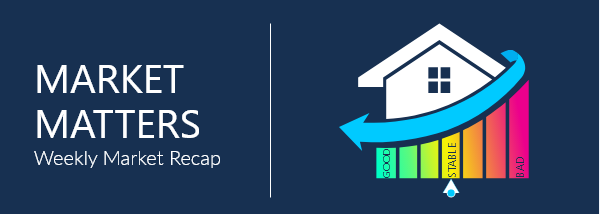Market Matters

We had plenty of Fed speak this week, with Thursday Fed Chairman Powell saying that a 50 bps rate hike in May was on the table. This is what the market expected for the most part, St. Louis President Bullard has been calling for a 75 bps rate hike so that wasn't as hawkish as he could have been. Still the market tightened with the Powell speaking, and the market priced in 6 rate hikes for the July 7/27 meeting, which is basically three 50 bps rate hikes. Looking at the end of the day on Thursday those six rate hikes for the July meeting are no longer priced into the market. Feels a bit hawkish for me but the market has been pricing in hawkish Fed action all year and for the most part those bets have been spot on I'd still be defensive here. Still oversold here so it wouldn't shock me to see a bounce, but the market has been oversold for some time so if you see any rallies best to take them.
 NAHB Housing Market Index
NAHB Housing Market Index
The National Association of Home Builders' Housing Market Index declined by -2.0 points in April, dropping from 79 to 77. This is now the lowest level since last September and the fourth consecutive decline from December's print at 84.0. According to the NAHB, "Despite low existing inventory, builders report sales traffic and current sales conditions have declined to their lowest points since last summer as a sharp jump in mortgage rates and persistent supply chain disruptions continue to unsettle the housing market." They said that the market faces an "inflection point", with affordability suffering from higher rates, home prices, and higher material costs, "particularly in the crucial entry-level market." The buyer traffic index was down -6.0 points to 60 and is now lower by -11.0 points in four months. The current sales component was also weaker, down -2.0 points to 85.0. Despite weakening affordability, the six month ahead expected sales index rose 3.0 points to 73.0.
 Existing Home Sales
Existing Home Sales
Sales of existing homes fell -2.7% in March to a seasonally adjusted annualized rate of 5.77mln units according to the National Association of Realtors. We also saw revisions to February, down from 6.02mln to 5.93mln. Looking back year over year, March sales were -4.5% lower than the same period in 2021. The median price of an existing home sold in March was $375,300, an increase of 15% vs. March 2021. At the end of March, there were 950k homes for sale, a decline of -9.5% year over year. At the current sales pace, this represents a two-month supply. According to the NAR, "The housing market is starting to feel the impact of sharply rising mortgage rates and higher inflation taking a hit on purchasing power. Still, homes are selling rapidly, and home price gains remain in the double-digits." Despite the higher rates, however, "It appears first-time homebuyers are still looking to lock in at current mortgage rates before they inevitably increase."
 Housing Starts
Housing Starts
Housing starts increased by .3% in March to a seasonally adjusted annual rate of 1.793mln units vs. a revised 1.788mln in the prior month. Starts were 3.9% above the March 2021 rate of 1.725mln. Single-family starts in March were down -1.7% to 1.2mln from the revised February figure of 1.221mln. Multi-family starts were up 7.5% to 574k. Building permits rose .4% to 1.873mln units in March and are up 6.7% above the March 2021 rate of 1.755mln units. Single-family permits were at a rate of 1.147mln, which is down by -4.8% below the revised February print at 1.205mln. Multi-family permits were at a rate of 672k, which is up a strong 10.9%. Broken out by region, the South saw overall starts plunge from 1.007mln to 834k, while the Northeast had them spike from 139k to 293k. They were up in the West to 434k from 403k, but down in the Midwest to 232k from 239k. On the permits side, there were gains in the Northeast (190k from 171k) and Midwest (258k from 251k) offset by declines in the South (959k from 960k) and West (466k from 483k).
 Mortgage Applications
Mortgage Applications
The MBA weekly mortgage applications index declined -5.0% for the week ending April 15th. Purchase applications fell -2.0% and were -14.0% lower than the same week a year ago. Refinance applications declined by -8.0% and were -68.0% lower vs. the same week last year. "Ongoing concerns about rapid inflation and tighter US monetary policy continued to push Treasury yields higher, driving mortgage rates to their highest level in over a decade. Rates increased across the board for all loan types, with the 30-year fixed rate hitting 5.2%, the highest level since 2010," said Joel Kan, MBA's Associate Vice President of Economic and Industry Forecasting. "The 30-year rate has increased 70 basis points over the past month and is 2 full percentage points higher than a year ago. The recent surge in mortgage rates has shut most borrowers out of rate/term refinances, causing the refinance index to fall for the sixth consecutive week. In a housing market facing affordability challenges and low inventory, higher rates are causing a pullback or delay in home purchase demand as well. Home purchase activity has been volatile in recent weeks and has yet to see the typical pick up for this time of the year."

